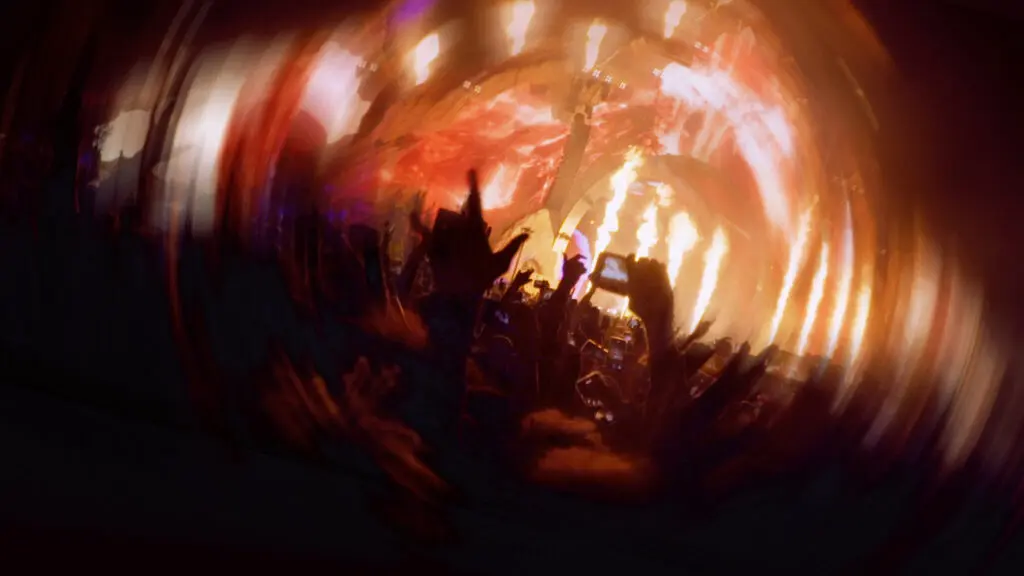
Netflix love a themed series. In the absence of Untold – which concluded its fifth “season” with Shooting Guards, The Liver King, and The Fall of Favre – a string of disaster documentaries under the Trainwreck banner begins with The Astroworld Tragedy. And if it’s the sign of things to come, buckle up – there’s horror ahead.
And that, if nothing else, is the real selling point of this 80-minute feature from directors Yemi Bamiro and Hannah Poulter. It’s a film about a horrifying tragedy that succeeds in being effectively horrifying. There are stretches here, enhanced with first-hand testimony, that play out so similarly to a horror movie that the effect is striking. If you’ve never imagined yourself being crushed to death in a mosh pit – and, frankly, why would you have? – then proceed with caution. Even the film’s key art (see above) has a nattily disorienting quality to it.
Six Flags AstroWorld was a Houston amusement park that was shuttered in 2005, which I didn’t know until it was brought up here. But it explains a lot. Travis Scott, the Houston-born rapper who has developed over the years a reputation for concerts that frequently descend into chaos, has mythologized the nostalgia of AstroWorld by naming his album and annual festival after it, trying to reliably recreate the feeling of visiting as a child. In 2021, the Astroworld Festival – conceived this time as a two-day fusion of theme park and music concert, much bigger in scale than any of the preceding events – wasn’t just a leveraging of that childlike affection but a tremendous outpouring of human energy post-pandemic.

The concert was a disaster that resulted in the deaths of ten people – including a nine-year-old – and left hundreds injured. Trainwreck: The Astroworld Tragedy is laced with condemnation for it, recounting step by step how the crowd swelled to deadly proportions, event security and organizers totally lost control, and the performance kept going, all while people were crushed, suffocated, and trampled.
Primarily, the story is told through accounts of people who were actually there, and their testimony is supplemented with truly harrowing phone footage. But the smartest flourish is the inclusion of Scott Davidson, an event safety expert who was brought in after the tragedy to determine what went wrong. His shock over a laundry list of logistical failures and ignored warning signs is truly damning; even by professional standards, Astroworld was a monumental travesty.
While the human-driven storytelling constitutes the bulk and a lot of the power of this film – and there are truly lingering images, like one interviewee begging for the show to be stopped at stage-side, and concertgoers atop camera towers pleading for help and safety – it should be lauded for how well it explains the specific missteps in layman’s terms. The venue could supposedly hold 50,000 people, but unlike most festivals featuring multiple stages and performers that would disperse audiences relatively evenly between each, Travis Scott was the star of Astroworld. Everyone wanted to see him, so he performed after the other acts, on a stage that had been reserved exclusively for his arrival. That stage could only support 35,000 people if things were well organized, which they weren’t – the timing meant that everyone flooded to the stage at the same time from the same side, creating a crushing pocket of disaster.
And the show continued nonetheless. Davidson’s claims make it clear that Live Nation, who promoted the event, must have known that it was over-capacity even before countless numbers of unticketed attendees broke in. Texts and emails prove it. And yet the plug was never pulled. The two people who had the authority to do so seemed to disappear during the chaos, leaving the desperate crowd to fend for themselves, and that feeling of powerlessness is made palpable here.
Predictably, a Houston grand jury found no individual criminally responsible for the tragedy, despite the film arguing quite cogently that there must have been at least one person who was. Lawsuits were brought against Live Nation, Travis Scott himself, and others, but all have since been settled out of court. It’s likely that the victims and their families who still want justice will never get it. The show must go on.


